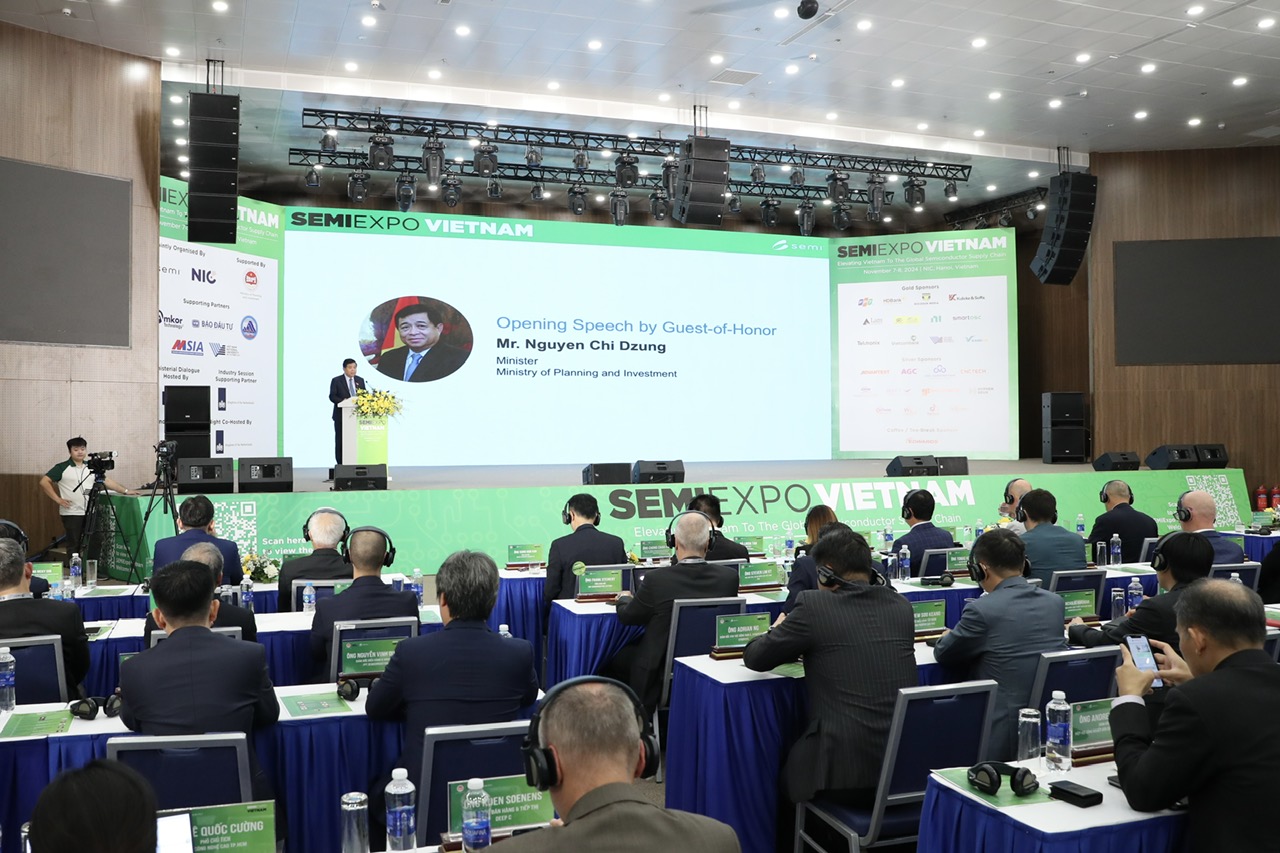Semiconductor market reaches $18.2 billion: SEMIEXPO Vietnam 2024
Vietnam a key player in tackling the challenges facing the global semiconductor supply chain.
Vietnam’s semiconductor market is projected to reach US$18.2 billion this year, with a compound annual growth rate of nearly 11.5%, according to the Global Semiconductor Association.
This announcement was made during a series of events at SEMIEXPO Vietnam 2024, taking place from November 7 to 8 at Hoa Lac Hi-tech Park.
| Delegates attend the opening ceremony of the exhibition. Photos: MPI |
KC Ang, Chairman of the Southeast Asia Advisory Council for the Global Semiconductor Association (SEMI) and President of Asia for Global Foundries, said that market revenue is expected to reach $31.4 billion by 2029.
He attributed this forecast to the unprecedented growth of the global semiconductor industry and highlighted Vietnam's emergence as a semiconductor powerhouse in the region. This progress is driven by the government's long-term vision to develop a comprehensive
semiconductor ecosystem by 2050. Key initiatives include plans to train 50,000 engineers in semiconductor technology and the establishment of a National Steering Committee for the sector.
He said that with a solid foundation established by the Vietnamese government and the determination of its leaders, Vietnam has become a dynamic hub for innovation and a key factor in tackling global semiconductor supply chain challenges.
From integrated circuit design to assembly, testing, and packaging, Vietnam is well-positioned to participate at every stage of the semiconductor value chain, the Global Semiconductor Association’s leader predicted.
Mariam Sherman, the World Bank in Country Director for Vietnam, Laos, and Cambodia, echoed the sentiment that global technology companies have been increasingly expanding their operations and establishing production facilities in Vietnam. This trend has generated quality jobs and accelerated economic growth, positioning Vietnam as one of the region’s major manufacturing hubs.
She noted that with a strong foundation in primary education, the next step for Vietnam is to invest in higher education to develop a high-quality workforce for the future.
"Vietnam's path forward is relatively clear, with key goals focused on developing human resources. This is how Vietnam can transform from a manufacturing center to a high-tech hub on the global stage," said Sherman.
Commenting on Vietnam’s potential in the semiconductor industry, Kees van Baar, the Dutch Ambassador to Vietnam, said the extensive supply chain involved in semiconductor manufacturing, which includes many large and small enterprises worldwide across various segments.
He suggested Vietnam foster its existing auxiliary industries to engage more deeply in this value chain and collaborate with experienced partners, such as the Netherlands, to enhance its semiconductor manufacturing capabilities.
In discussions with partners and investors, Nguyen Chi Dung, Minister of Planning and Investment, said that Vietnam is becoming a significant customer and partner for global technology giants such as Google, Meta, and Amazon, with an expanding market share.
| Nguyen Chi Dung, Minister of Planning and Investment, speaks at the event. |
He emphasized that Vietnam is actively collaborating with the US, Japan, South Korea, Singapore, and Taiwan (China) to train personnel and develop the semiconductor and artificial intelligence industries.
The minister said Vietnam is working to create an attractive business environment with numerous incentives for high-tech companies. In 2024, the government plans to issue a decree regarding the establishment, management, and use of an investment support fund aimed at directly assisting businesses in this sector with training, human resource development, fixed asset investment, and high-tech product manufacturing.
“The National Innovation Center (NIC), along with three high-tech parks in Ho Chi Minh City, Hanoi, and Danang, is well-prepared to welcome semiconductor investors with favorable support mechanisms and incentives,” said Dung.
Vietnam's goal goes beyond simply participating in the global value chain. The country aims to build an advanced and attractive semiconductor ecosystem that fosters self-sufficiency and sustainable development in the sector."
Under the theme “Elevating Vietnam in the Global Semiconductor Supply Chain,” SEMIEXPO Vietnam 2024—the first and largest international semiconductor exhibition held in Vietnam—opened on November 7 at the NIC campus in Hoa Lac Hi-tech Park. Minister of Planning and Investment Nguyen Chi Dung said that this event marks a significant step forward for Vietnam in its efforts to engage with the global semiconductor industry value chain. The exhibition has attracted over 5,000 delegates and featured 100 booths from major technology partners in the semiconductor sector, including Cadence, Qualcomm, Intel, Qorvo, Dassault Systèmes, Siemens, Synopsys, Marvell, Tektronix, FPT, and Viettel. The event has also attracted participation from stakeholders within the semiconductor ecosystem, including research institutes, universities, investment funds, businesses, organizations, associations, and experts from both domestic and international backgrounds in the field. During the event on November 6, Minister Dung and delegates witnessed the announcement of a partnership between the Ministry of Planning and Investment's NIC and its partners aimed at developing the semiconductor industry in Vietnam. A series of workshops, forums, exhibitions, business networking programs, and industry connection sessions are scheduled to take place on November 8 in Hoa Lac Hi-tech Park. |













